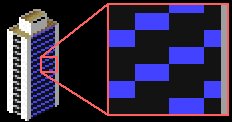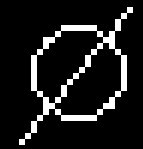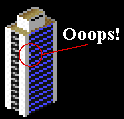Everything that you see on your computer screen is made up of pixels - the smallest "dots" that your monitor and video card can produce at the video setting you have configured. As you can see in the nice jpeg of downtown L.A. below, pixels aren't actually dots - they're squares:
Not suprisingly, SimCity works the same way - everything you see is made up of pixels - small squares. With SCURK you can manipulate those pixels, and in the edit view you can zoom in on them and place them one at a time with the paintbrush tool. "Hold on!" you're probably thinking, "does this mean that I have to individually place each and every pixel in a tile? - there must be thousands!" Well, not exactly... SCURK gives you some basic, but very usefull, graphics editor tools to work with. (BTW, there are 16,384 pixels in a 1x1 tile). The most important tools are <Cut> and <Paste>, allowing you to grab a piece of a drawing and repeat it. Repetition -it's the key to SCURK.
 Am
I repeating myself?
Am
I repeating myself? This
is a circle with a line through it...yuch!
This
is a circle with a line through it...yuch!
Here's another piece of bad news: in SimCity, if the "world" is 5 miles across like it claims in the manual, then each pixel is 14 feet across! How can you draw a person or a telephone pole or even a window or a door at that scale?!? TIP #1: You can't. Forget about exact scale from the begining - think about relative scale. Guess what the next section is about? ;-)
Fortunately, there is a whole bag of tricks that computer
graphics designers have worked out over the years that are perfectly adaptable
to SCURK. You can "fool" the eye into thinking that it is seeing a perfect
circle, a three-dimensional structure, the leaves of a tree, or intricate
architectural details. This, for me, is the real fun of SCURK - convincing
the viewer to see what I want him to see and thereby model the city that
I envision in my own mind's eye. I hope these pages of SCURK Tips will
help you show others what's in your head.
 |
 |
| saci@voicenet.com |